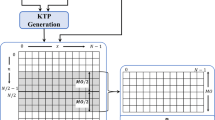Abstract
The detection of shot boundaries in videos captures the structure of the image sequences by the identification of transitional effects. This task is important in the video indexing and retrieval domain. The video slice or visual rhythm is a single two-dimensional image sampling that has been used to detect several types of video events, including transitions. We use the longest common subsequence (LCS) between two strings to transform the video slice into one-dimensional signals obtaining a highly simplified representation of the video content. We also developed a chain of mathematical morphology operations over these signals leading to the detection of the most frequent video transitions, namely, cut, fade, and wipe. The algorithms are tested with success with various genres of videos.





Similar content being viewed by others
Notes
2001 TREC Video Retrieval Test Collection, available at http://www.open-video.org.
References
Aigrain P, Joly P (1994) The automatic real-time analysis of film editing and transition effects and its applications. Comp Graphics 18(1):93–103
Bezerra FN (2004) A longest common subsequence approach to detect cut and wipe video transitions. In: Proceedings of Brazilian symposium on computer graphics and image processing. Brazilian Computer Society, IEEE Computer Society, pp 154–161.
Bezerra FN, Leite NJ (2003) Video transition detection using string matching: preliminary results. In: Proceedings of Brazilian symposium on computer graphics and image processing. Brazilian Computer Society, IEEE Computer Society, pp 339–346
Browne P, Smeaton A, N Murphy N, N O’Connor N, Marlow S, Berrut C (2000) Evaluating and combining digital video shot boundary detection algorithms. In: IMVIP 2000—Irish machine vision and image processing conference
Bèscos J (2004) Real-time shot change detection over online mpeg-2 video. IEEE Transactions on circuits and systems for video technology 14(4):475–484
Cooper M, Foote J (2001) Scene boundary detection via video self- similarity analysis. In: IEEE international conference on image processing (3), pp 378–381
Deardoff E, Little TDC, Marshall JD, Venkatesh D, Walzer R (1994) Video scene decomposition with the motion picture parser. In: Proceedings of the IS&T SPIE Symposium on electronic imaging science and technology (digital video compression and processing on personal computer: algorithms and technologies), vol 2187. pp 44–55
del Bimbo A (1999) Visual information retrieval. Morgan Kaufmann
Demarty CH (2000) Segmentation et structuration d’un document Vidéo pour la Charactérisation et l’Indexation de son Contenu Sémantique. PhD thesis, ENSMP, France
Chung MG et al. (1999) Automatic video segmentation based in spatio-temporal features. Korea Telecom J 4(1):4–14
Fernando WAC, Canagarajah CN, Bull DR (1999) Fade and dissolve detection in uncompressed and compressed video sequences. In: Proceedings of the IEEE ICIP, pp 299–303
Grimaud M (1992) A new measure of contrast: the dynamics. SPIE Image algebra and morphological processing III 1769:292–305
Guimarães SJF, Couprie M, Araújo AA, Leite NJ (2003) Video segmentation based on 2d image analysis. Patt Recogn Lett 24:947–957
Hampapur A, Jain R, Weymouth TE (1995) Production model based digital video segmentation. J Multimedia Tools Appl 1(1):9–46
Kim H, Lee J, Yang J, W. Kim S. Sull, Song SM (2001) Visual rhythm and shot verification. Multimedia Tools Appl 15:227–245
Kim H, Park S-J, Lee J, Kim WM, Song SM-H (1999) Processing of partial video data for detection of wipes. In: Proceedings of storage and retrieval for Image and video databases VIII, vol 3656. SPIE, pp 280–289
Nagasaka A, Tanaka Y (1992) Automatic video indexing and full video search for object appearances. IFIP Transactions, Visual Database Systems II, pp 113–127
Navarro G (2001) A guided tour to approximate string matching. ACM Comp Surveys 33(1):31–88
Ngo CW, Pong TC, Chin RT (1999) Detection of gradual transitions through temporal slide analysis. In: IEEE CVPR, pp 36–41
Ngo CW, Pong TC, Chin RT (2001) Video partitioning by temporal slice coherency. IEEE Trans Circuits, Syst Video Technol 11(8):941–953
Osian M, Van Gool L (2003) Video shot characterization. TREC Video Retrieval Evaluation, NIST
S. Sorgi P. Campisi, Neri A (2002) Wipe effect detection for video sequences. In: Proceedings of the IEEE 2002 workshop on multimedia signal processing, pp 9–11
Soille P (2003) Morphological image analysis: principles and applications, 2nd edn. Springer, Berlin Heidelberg New York
Tonomura Y, Akutsu A, Otsuji K, Sadakata T (1993) Videomap and videospaceicon: tools for anatomizing video content. In: ACM Interchi, pp 131–136
Whitehead A, Bose J, Laganière R (2004) Feature based cut detection with automatic threshold selection. In: International symposium on signal processing and applications, pp 410–418, Paris
Wu M, Wolf W, Liu B (1998) An algorithm for wipe detection. In: IEEE international conference on image processing, pp 893–897
Yuan J, Li J, Lin F, Zhang B (2005) A unified shot boundary detection framework based on graph partition model. In: Proceedings of the 13th annual ACM international conference on multimedia, pp 539–542
Zabih R, Miller J, Mai K (1995) A feature-based algorithm for detecting and classifying scene breaks. In: Proceedings of the 3rd international ACM international conference on multimedia, pp 189–200
Zhang HJ, Kankanhalli A, Smoliar S (1993) Automatic partitioning of full-motion video. Multimedia Syst 1(1):10–28
Zhang HJ, Low CY, Gong Y, Smoliar S (1994) Video parsing using compressed data. In: Proceedings SPIE image and video processing II, vol 2172. pp 142–149
Zhang HJ, Smoliar SW (1994) Developing power tools for video indexing and retrieval. In: storage and retrieval for image and video databases II, vol 2185 of SPIE proceedings series, pp 140–149
Author information
Authors and Affiliations
Corresponding author
Rights and permissions
About this article
Cite this article
Bezerra, F.N., Leite, N.J. Using string matching to detect video transitions. Pattern Anal Applic 10, 45–54 (2007). https://doi.org/10.1007/s10044-006-0049-3
Received:
Accepted:
Published:
Issue Date:
DOI: https://doi.org/10.1007/s10044-006-0049-3




